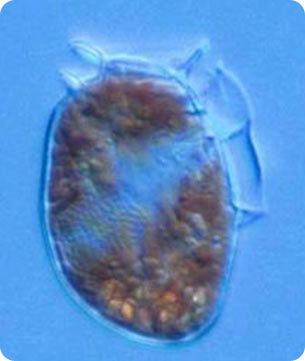The law of the jungle -- whether on land or in the sea -- is usually that the big guys eat the little guys. But there are some exceptions. In the sea, one of those exceptions is a tiny organism known as Dinophysis. Not only does it eat creatures that are bigger than itself, but it waits patiently for the big guys to grab it.
 Dinophysis. Credit: Dr. T. A. Villareal, Univ. of Texas, Austin.
Dinophysis. Credit: Dr. T. A. Villareal, Univ. of Texas, Austin. Dinophysis is a single-celled creature that’s part of a large family of marine organisms known as dinoflagellates. They’re found all around the world, in waters warm and cold, and some of them create the toxic blooms known as red tides. Others, including Dinophysis, are responsible for some types of shellfish poisoning.
Many dinoflagellates are plants -- they use sunlight and nutrients in the water to produce food. But a few eat other organisms.
One of the favorite meals of Dinophysis is a tapered, rocket-shaped organism known as Tiarina. It’s a fast swimmer, and it’s covered with tiny hair-like structures that grab its prey.
Tiarina sometimes grabs a Dinophysis, which turns out to be a bad move. The armored Dinophysis, which is a bit smaller, instead latches on to Tiarina. The bigger, faster organism then tries to swim away, dragging its would-be prey along with it. But Dinophysis extends a feeding tube that pierces Tiarina’s body. In a few minutes, Tiarina stops moving. Dinophysis then vacuums out its prey; in a few hours, nothing is left but an empty sack.
So the law of the jungle doesn’t always apply. Sometimes, the little guy wins the battle.

